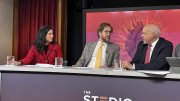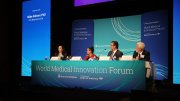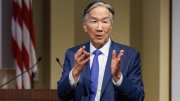Heart disease kills more Americans every year than all cancers combined. Yet a cancer diagnosis prompts immediate action and mobilizes families, said Ami Bhatt ’96, one of a panel of heart disease experts who spoke at the Harvard T. H. Chan School of Public Health on February 26, while a diagnosis of heart disease doesn’t elicit the same sense of urgency. The panelists discussed innovations in risk assessment, diagnosis, and patient adherence to drug regimens; the importance of health screening, education, and lifestyle factors in cardiovascular wellbeing; and technical advances in surgery—including the ability to operate on a still-beating heart.
Bhatt, chief innovation officer at the American College of Cardiology, said that emerging technologies will soon enable physicians to better communicate cardiovascular risk to patients. Advances in imaging, combined with AI diagnostic tools, can detect the beginnings of a vascular blockage—and determine which blockages appear stable and which could cause catastrophic harm. “Now, all of a sudden,” she said, “you’ve captured somebody’s attention just as a cancer diagnosis would.
Joseph Woo, chair of the department of cardiothoracic surgery at Stanford Medicine and associate director of the Stanford Cardiovascular Institute, agreed. “When I’m seeing patients, I try to remind them that… if they ever heard they had a cancer inside, regardless of how slow growing,” they would want to treat it right away. “Yet there are people who have cardiovascular disease who say, ‘Well, I’ll wait till next year,’ or ‘I want to wait till this graduation or this vacation.’ Very few people would say, ‘Well, I’ll wait till next year’s summer vacation to get my cancer taken out.’ It’s our job as physicians to increase awareness that waiting only causes more damage to the heart,” he said. “We need to enhance this sense of urgency for the treatment of cardiovascular disease from the very beginning, from screening all the way through intense interventions.”
Diagnosis—and Barriers to Treatment
Heart disease can begin during a person’s twenties. That’s why everyone should know their lipid profile before the age of 21, said associate professor of medicine Jorge Plutzky, director of preventive cardiology at Brigham and Women’s Hospital (BWH)—“a position endorsed by a lot of our professional societies.” Beyond that, he added, “The ability to detect atherosclerosis,” the disease that underlies coronary events including heart attacks and strokes, enables physicians to intervene before there has been a clinical event—a stark shift in the treatment paradigm: “How backwards were we,” he asked, “when we were thinking, let’s wait for someone to have an event and then we’ll be very aggressive about preventing” further episodes? The ability to understand and calculate risk, he said, “can help fuel earlier intervention, and that can make all the difference.”
But there are vast discrepancies in patient adoption of proven therapies: drugs work, explained Plutzky, but their use is not consistent across all segments of the population: “We see lots of different barriers to care.” At one end of the spectrum, even when a patient is identified as needing cholesterol-lowering drugs and begins a course of treatment, a “high percentage of patients are no longer on the drug” after one year. The reasons range from obstacles to picking up a prescription, to coordinating insurance approvals, to physician failure to communicate the importance of the treatment—a gap in education.
He shared an anecdote that illustrates the latter. At the BWH lipid prevention clinic, patients who have self-referred themselves (“often affluent and educated”) demand he help them lower their low-density lipoprotein (LDL) cholesterol levels. (High levels of this “bad” cholesterol can lead to build up of plaque in the arteries, raising the risk of heart attacks and strokes.) “It’s such a contrast to the patients who are getting admitted at the Brigham, who have gone untreated despite our knowing that they had significant risk issues.” He recalled several times struggling to convince a patient to take a statin, when an assisting 25- or 28 -year-old resident would chime in and disclose that they were taking a statin. “Why are you taking a statin,” Plutzky would ask? And they would reply, “‘Well, my LDL is 121 or 130’”—not very high, but not optimal.” The contrast, Plutzky said, “frames a lot of the challenges for us: what does that resident doctor or cardiology fellow at the Brigham know” that the patient doesn’t? “Bridging that gap is really at the core of effectively communicating what the issue is and why you want to [prescribe treatment]. We need novel strategies to overcome all those barriers in order to really improve public health.”
Technology has proven useful to that end. Bhatt described a recent partnership with a large healthcare system to develop an automated messaging system that prompts both physicians and then, two weeks later, patients, to get their LDL checked every two years. At BWH, algorithms are being deployed to identify patients who could benefit from “navigators” who are trained to facilitate treatment. Often when they reach former coronary-bypass surgery patients and ask why their LDL is suddenly elevated again, the answer can be as simple as “I tried to get it renewed and never heard back” or “I moved.” The aide, who is neither a physician nor a nurse, can fix that problem by having prescriptions filled, explaining why patients should take it, and getting them back into treatment. These systems are highly effective, testified Bhatt, better even than the most conscientious—but notoriously busy—physicians.
From Minimally Invasive Surgery to “Digital Twins”
The panelists also discussed advances in surgical interventions—appropriately, since the event also marked the tenth anniversary of the public health school’s Dr. Lawrence H. and Roberta Cohn Forum. Cohn, a cardiac surgeon, was part of the team that in 1984 performed the first heart transplant in New England and was renowned for pioneering cardiac surgical techniques.
Tommaso Danesi, section chief of valve surgery and director of the endoscopic valvular program at BWH, described how surgeons have “sharpened the trajectory of being less invasive,” building on Cohn’s legacy. Endoscopic mitral valve surgery today is made through incisions of less than two centimeters, he explained, is successful more than 95 percent of the time, and is durable for 30 years. Recovery from standard surgery could take roughly two to three months, while the endoscopic, minimally invasive approach enables patients to return home within four days and almost fully recover in two to three weeks. This advance in the speed of recovery has improved patient acceptance of such procedures, and greatly eased the burden of support provided by patients’ families.
The use of autonomous robots in cardiac surgery (see “The Medical-Robotics Revolution”), could bring further improvements in patient outcomes and shortened recovery times, but at the moment, said Danesi, the robots used in surgery are “just an augmented extension of the surgeon—a pantograph.” But, he cautioned, further development of AI-controlled robots that operate independently and with more precision than a human does raise questions about the role of the surgeon 15 to 20 years from now.
In the meantime, Bhatt said, she is excited about the potential of using digital twins—virtual models of a patient’s unique cardiac physiology created with 3-D imaging technologies—to prep for surgery. And Woo highlighted the use of AI to plan surgeries, including contingencies that could be implemented (“plan B, C, or D”) in real-time.
He also described the ability to keep donor hearts beating during transport and implantation into patients. “This new technology allows you to take the donor heart and put it on a machine that sends blood into the heart and keeps it nourished. So, while you’re traveling in an airplane with that donor heart back to the recipient hospital, the heart is beating….The standard way of implanting that heart was to stop it and sew it in while it was still.” Woo’s team figured out how to keep the heart beating during implantation. “That’s really what was so exciting. It’s out of the patient, it’s beating, and we’re starting to sew it into the recipient. And…because it’s already beating, as soon as you finish sewing it in, it’s ready to take over the work of the pumping of the blood for the patient. And so, they jump right off of the heart-lung machine, and go right to the intensive care unit.” (Woo performed the first such surgery in 2022.) More than 15 heart transplant centers across the United States now use the technique, which, by allowing donor hearts to come from farther distances, may enable more patients to receive transplants.
Preventing Disease and Maintaining Cardiac Health
There has been major progress in treating heart disease with drugs that lower cholesterol, control blood pressure, and lead to weight loss. Plutzky was involved in some of the clinical trials that proved that weight-lowering GLP-1 receptor agonist drugs such as Ozempic and Wegovy, originally developed to treat diabetes, also lower cardiovascular risk—beyond what was possible with blood pressure and cholesterol-lowering drugs. “The fact that you could do that on top of our current standard of care was really a breakthrough,” said Plutzky, “and it established that obesity is a disease—a real issue—and there’s an opportunity to improve outcomes through the use of these agents. And of course, we see that exploding.”
But he added what everyone knows: that “Lifestyle still matters. It does matter how we eat and how active we are, and that can be an important component of not getting to the point where now we’re trying to overcome other issues.”
A closing question posed to the panelists sought their views on the most important ways to keep one’s heart healthy—eliciting answers ranging from better diet to less stress.
Woo emphasized the importance of eating well, sleeping well, and living a healthy lifestyle.
Bhatt underscored “the effect of stress on our hearts. Take time for yourself, slow down a little bit. Put the phone down when you’re talking to your friends or your family. Find ways to connect. If you can walk safely, walk instead of grabbing a glass of wine with someone.” Try “90 seconds at a time of deep breathing. I think we all need to move toward just a generally less stressful life. And then, of course, if we or our loved ones have mental health problems…get people the help that they need.”
Danesi said he recommends that almost every patient “start taking care of your heart before hearing from him” because disease can start 20 years earlier.
And Plutzky urged everyone to know their numbers, and not just lipid levels: “Know your blood pressure, know your weight, know your glucose levels.” Understand what those numbers mean, and don’t be scared of treatment. At one time, pneumonia was the number one cause of mortality. But with antibiotics, pneumonia faded in importance, leading to the primacy of heart disease. Now there are drugs to treat cardiac health problems, he said, and “it’s imperative to understand why we’re all talking about cholesterol and diabetes and weight and blood pressure, and the impact that can have on what is the number one killer and threat to every American.”








